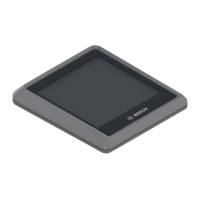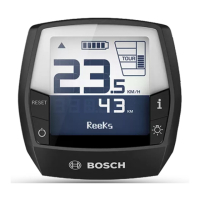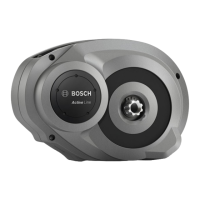MY23P0a -52_1.0_11.10.2022
40
Description
3.3.2.8 Handlebars
The pedelec is steered using the handlebars. The
handlebars are used to support the upper body
and is the mount for operating and display
components (see Section 3.5.1).
Figure 13: Handlebar dimensions
The main dimensions of handlebars are:
1 Rise (height)
2 Width
3 Backsweep
3.3.2.9 Suspension fork
The stem and handlebars are attached to the top
end of the fork steerer. The axle is fastened to the
fork ends. The wheel is fastened to the axle.
Unlike rigid forks, suspension forks improve
contact with the ground and thus enhance comfort
using two functions:
• Suspension and
• Damping (optional function).
The compression can be disabled in any
suspension fork. A suspension fork will then
behave like a rigid fork.
Suspension
A suspension fork deflects when a steel
suspension, air suspension or both suspension
types act on it.
The suspension in a pedelec prevents an impact,
such as one caused by a stone lying in the
pedelec’s path, from being channelled directly into
the rider’s body via the fork. The impact is
absorbed by the suspension system instead. This
causes the suspension fork to compress.
Figure 14: Without suspension (1) and with
suspension (2)
Damping
After compressing, the suspension fork returns to
its original position. If there is a damper, it
decelerates movement, preventing the
suspension system from springing back in an
uncontrolled manner and stopping the fork from
vibrating up and down. A distinction is made
between two types of dampers:
• Rebound dampers,
• Compression dampers.
Rebound dampers and compression dampers can
be optionally divided into two different sections:
• High-speed damper,
• Low-speed movements.

